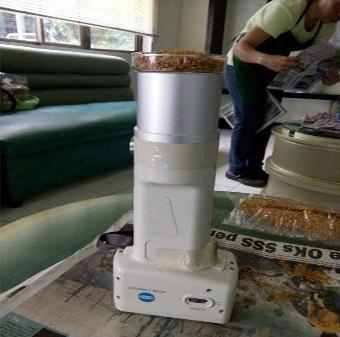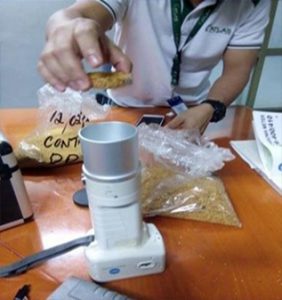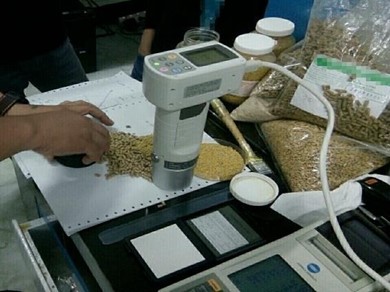INTRODUCTION
Animal feed is a food grown or developed for livestock and poultry. Modern feeds are produced by carefully selecting and blending ingredients to provide highly nutritional diets that both maintain the health of the animals and increase quality of such end products as meat, milk or eggs. Ongoing improvement in animal diets have resulted from research, experimentation and chemical analysis by agricultural scientist. (https://www.britannica.com/topic/feed-agriculture)
With a growing trend and innovation in animal feed production for the past decades, color has been popularly used as a basic indicator quality. Color usually correlates with some nutritional qualities of feed according to some development research studies and it is also used by buyers especially in the export market to determine appearance quality of finished feed product. For the animal feed industry, color evaluation plays a broad application starting from the raw material/ingredients to finished product itself.
Color Measurement in the Feed Manufacturing Process
Just like in the human food manufacturing process, Animal feed color measurement can be performed in stages of manufacturing process. Started from ingredients preparation (corn, oil, soy, distilled grains, wheat, etc.), coating pre-application, after heating process and in the finished product where it was cooled down and before it will be put into the sack.
Commonly, color measurement takes place at the end of the process with the finished product itself. For some feed product, feed manufacturer used feed coating just for aesthetic purpose only, they measure the feed with applied coating before it is packaged, shipped off and distribute for retail. In some case they measure the coating and pellet separately just to make ensure both ingredients are satisfactory. This oil and fat based coating can change the color and appearance of the feed pellet and an unwanted product can result to reject batches. That is why it is important to determine, is it the feed or the coating is at off-color? On some point, the feed is heated, cooled and been formed into its final shape. A discrepancy in color at this point may indicate a problem with the heating process. A feed that is overheated may appear darker and, alternatively, if it is under-heated it will appear lighter. These changes in color and appearance can be noticed by the feed buyers. Depending on the color tolerance required by the Quality Assurance personnel, color measurement procedure plays a vital role in the process as it prevents production of the batches that is not fit for commercialization.
Color measurement application in animal feed seems complicated but the color measurement in those process will help to prevent production and distribution of unwanted batches of animal feed products therefore saving time and cost at the end and improving feed formulation and producing consistent feed quality afterwards.
DDGS: INGREDIENT FOR SWINE FEED PRODUCTION; DDGS COLOR AND IT’S SIGNIFICANT TO NUTRITIONAL CONTENT VALUE
DDGS (Distillers Dried Grain with Solubles) are the nutrient co-product of dry-milled ethanol production. Its utilization as feed ingredient is well documented as both an energy and a protein supplement. (http://www.grains.org/buyingselling/ddgs)
Color has been used as a subjective indicator of the nutritional quality of feed ingredients for decades. In 1912, Louis Camille Maillard described the first evidence of chemical reactions between sugars and amino acids that render the amino acids (especially lysine) indigestible. These reactions commonly occur when mid- to high-protein feed ingredients are overheated during the production and drying process, and can be characterized by darkening of color (browning), burned flavor and smell. Drying temperatures used in dry-grind ethanol plants can range from 127 to 621 degrees Celsius (260 to 1,150 degrees Fahrenheit). The nutritional significance of the Maillard reactions in DDGS has been shown in past studies on ruminants, as well as in pigs and chickens, and is responsible for losses in protein quality in DDGS.
In addition, color can give an indication of the maturity of the grain, storage conditions, presence of toxins, contamination due to sand, and possible use of insecticides/fungicides, which give a dull and dusty appearance. Sorghum with an orange to red color may indicate high tannin content. Browning or blackening can indicate excessive heat treatment or spoilage due to improper storage, thus reducing nutritive value.
How do we quantify color for feed?
Konica Minolta chromameters have been used for many years in human food industry as indicators of nutritional and physical characteristics of heat-processed products such as coffee, fried products, and bread. Color is measured by reading three color characteristics specifically defined by the Commission Internationale d’Eclairage, in Vienna, Austria: L*, a measure of lightness with 0 being dark and 100 lighter; a*, measuring red-green; and b*, measuring yellow-blue. Colorimetric measurements of feed ingredients, especially for DDGS, have become common in the feed industry to assess the extent of heat damage.
DDGS color can be an indicator of nutritional value. Research done in 1948 was the first to show that excessive heating of feed ingredients can result in binding of amino acids and protein to other compounds, such as carbohydrates, thus reducing amino acid digestibility (especially lysine) in monogastric animals. As it translates to lysine concentration tends to be highest at lightest colored DDGS sources, intermediate in the medium colored and lowest at darkest colored DDGS sources.
(https://www.grains.org/sites/default/files/ddgs-handbook/Chapter-8.pdf)
In general, when evaluating DDGS sources for use in swine diets, it is ideal to come up with CIE L* (lightness of colour) reading higher than 50 to ensure above average lysine digestibility. With the help of a chromameter, objective Lightness (L*) evaluation of DDGS sample become easy to determine and quantify thus eliminating subjective visual color chart method evaluation
What Ideal Instrument You Can Use for Animal Feed Color Measurement?
Animal feed is a sensitive investment for every livestock farm owners, they’re willing to spend thousand or even million for tons of animal feed to make sure the animal feed being provided is good and in consistent quality every time. Quality control via color measurement should be a necessary procedure for every Animal feed manufacturers to ensure that the feed they manufactured meets the livestock farm owner’s visual quality demands and standards. The addition of color measurement practice in the animal feed production must not be a burden procedure, it is just important to look for an instrument that is durable, dependable and easy to operate along the process.

The CR-410 is a cost effective QC color measurement instrument with 50mm measuring aperture for either regular or irregularly colored or textured samples. Widely adopted in the food industry. The color data is measured as the eye sees and is reported in simple Lab format. The CR-410 is ideal for color inspection as it become a “defacto standard”, finished food products, ingredients and raw materials color measurement applications within production, quality control and R&D fields.
How to Measure Animal Feed? Feed Sample Measurement Preparation.
Using a petri-dish or a granular material attachment standard accessory is ideal to contained samples of feed granules, pellets or powder. GMA contained the samples and provide uniform surface within for an increased accuracy in taking measurement and requiring only small amount for measurement, reducing wastage and at the same time speed up the process of measurement for the user by reducing, discarding and filling feed samples.

